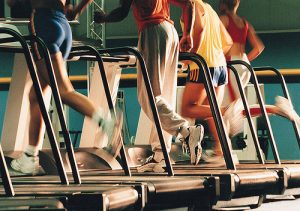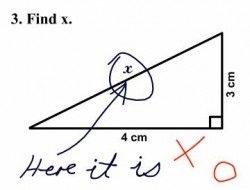Why You Should Do High-Intensity Interval Training (HIIT) Over “Traditional Cardio”
Overview
- High-Intensity Interval Training (HIIT) is a training method consisting of a period of sprinting followed by a rest duration or active recovery phase.
- HIIT is very time-efficient as you could burn the same or more calories in a 10-20 minute time period depending on your intensity and duration.
- HIIT workout sessions may yield higher increases in EPOC, maintaining an elevated metabolism for a longer duration throughout the day than compared to performing steady-state cardio.
- HIIT can be effective in reducing body weight and body fat, including in the abdominal region.
- HIIT programs may yield the same cardioprotective (i.e. protective elements against cardiovascular disease) benefits as prolonged aerobic exercise.
- There are a variety of different options to choose from for performing HIIT including the stationary bike, elliptical, and outdoor sprinting.
In this guide, we will cover five reasons why you should perform High-Intensity Interval Training (HIIT) over longer duration endurance training, or traditional cardio.
Furthermore, we will discuss actionable steps for performing HIIT safely and effectively with programming considerations for saving time while improving health and burning fat to create a leaner, more muscular physique.
What Is High-Intensity Interval Training, or “HIIT”?
High-Intensity Interval Training (HIIT) is a training method consisting of a period of sprinting followed by a rest duration or active recovery phase.
(This is not to be confused with “High Intensity Training”, or “HIT”. However, the two are similar due to the high-intensity nature of both types of exercise.)
Why do HIIT when you are already have traditional “cardio” (i.e. treadmill walking, jogging, endurance running) in your exercise program?
Here is why you should practice short bouts of high-intensity exercise as opposed to longer duration low-intensity exercise (i.e. traditional cardio):
Scenario: You have just exited your the local ice cream shop upon its closing with a double-scoop of chocolate chip cookie dough ice cream. As you exit, a robber steals your ice cream and runs into a dark alley. There are no other places nearby open for ice cream. If he runs for too long, it might melt! What do you do?
Do you…
A. Go home and cry hysterically.
B. Sprint! However, you train Low-Intensity Steady State Cardio (LISS), so you may ultimately catch the thief in an endurance race, but risk your ice cream melting in the hands of the robber!
C. Bang on the door of the ice cream shop demanding more ice cream as bystanders stop and stare.
D. Sprint! You trained High-Intensity Interval Training to sprint fast enough to catch and tackle him to retrieve your ice cream before it melts!
Hopefully, by following the actionable steps presented in this article, you will never have to experience anything but the last choice.
(If you are following a diet to reduce body fat and retain muscle and have – mistakenly – completely restricted ice cream from your diet, click HERE).
Here are five other important reasons for performing HIIT over LISS:
- Shorter Workout Length (Save Time)
- High Intensity (Burn More Calories Post-Exercise)
- Improve Body Composition (Decrease Body Fat, Including Belly Fat)
- Cardioprotective Benefits (Improve Health)
- Variation (Prevent Boredom)
1. Shorter Workout Length (Save Time)
What is the #1 time-saver for performing “cardio” and burning fat?
High-Intensity Interval Training, or “HIIT”.
Why spend upwards of 30-45 minutes jogging, when you could burn the same amount of calories, if not more, over a 24-hour period with only 10-20 minutes of HIIT?
HIIT is very time-efficient as you could burn the same or more calories in a 10-20 minute time period depending on your intensity and duration.
Furthermore, after your training session, you will continue to burn calories for a longer duration throughout the day, usually due to a higher “EPOC” (Excess Post-Oxygen Consumption).
What is EPOC?
2. High Intensity (Burn More Calories)
Have you noticed that even when you turn your car off, the engine still remains heated?
Our bodies work similarly with our cells as the “engine” and “heat” as the increase in metabolism from a bout of exercise.
The increased “heat”, or elevated metabolism, is referred to as Excess Post-Oxygen Consumption, or “EPOC”.
EPOC is a state in which our bodies consume oxygen to help restore our bodies to our more balanced, pre-exercise state.
A study conducted by the Journal of Sports Science identify that HIIT workout sessions may yield higher increases in EPOC for a longer duration throughout the day than compared to performing steady-state cardio.
During this period of EPOC after intense bouts of exercise such as HIIT, we burn even more calories than after longer duration, low-intensity exercise as our bodies are working harder to return to our more balanced, pre-exercise state (i.e. homeostasis).
3. Improve Body Composition (Reduce Body Fat, Including Belly Fat)
Can HIIT be effective in reducing body fat, including in the abdominal region?
One study conducted by International Journal of Obesity examined a group of young women who were randomly assigned to either a steady-state, high-intensity intermittent exercise, or a control group (maintained regular physical activity levels).
The high-intensity interval training group performed intervals three days per week for 15 weeks with the steady state group maintaining a similar frequency.
At the end of the 15 weeks, although both groups developed greater cardiorespiratory levels, only the high intensity interval training group saw significant decreases in total body fat, including abdominal fat.
4. Cardioprotective Benefits (Improve Health)
We already knew performing prolonged aerobic exercise (with oxygen) can be beneficial to our health, but what about short, high-intensity anaerobic (without oxygen) exercise?
Studies have indicated HIIT programs may yield the same cardioprotective (i.e. protective or preventative elements against cardiovascular disease) benefits as prolonged aerobic exercise including the following:
-Aerobic and Anaerobic Performance
The length of the HIIT program necessary to yield these benefits from an HIIT program varies.
As a general recommendation, start your HIIT program consisting of at least 2-3 times per week for 12 weeks to attain these cardioprotective benefits.
With HIIT, you can improve your health with less time than traditional endurance training protocols on the treadmill.
5. Variation (Prevent Boredom)
There are a variety of different options to choose from for performing HIIT including the following:
- Bodyweight Circuits
- Track/Outdoor Sprinting
- Hill Sprinting
- Stationary Bike
- Elliptical
- Concept 2 Rower
- Airdyne
- Jacob’s Ladder
For starters, my recommendation to clients is often to first start a HIIT program using a stationary bike and/or elliptical as opposed to other options including outdoor sprinting or hill sprinting.
Using the stationary bike and elliptical for HIIT affords the following benefits:
- Decreased Risk of Injury
- Measure Progression
- Adjust Resistance
To apply maximum intensity for HIIT, the stationary bike and elliptical are safer alternatives for beginners than other options including the treadmill or outdoor sprinting.
You are also able to easily adjust resistance throughout your workouts and use the provided variables (i.e. time, RPM, resistance level) on the machine to chart your progression throughout your program.
Furthermore, among other options, the stationary bike and elliptical are easily accessible in most commercial gyms.
How to Perform and Program High-Intensity Interval Training (HIIT)
To perform HIIT, begin with the following protocol:
- Perform a 5-10 minute warm-up at a low-to-moderate intensity (4-5 on an intensity scale from 1-10 with 10 being the highest intensity).
- Work Phase: Increase the level of resistance and sprint for 30 seconds for the work duration (8-9 on an intensity scale from 1-10 with 10 being the highest intensity.
- Active Recovery Phase: Decrease the level of resistance and pedal slowly for 90-120 seconds (4-5 on an intensity scale from 1-10 with 10 being the highest intensity). .
- Repeat.
Now that we understand how to perform HIIT, let us briefly examine how the factors including frequency, intensity, time, type, and enjoyment tie into programming.
Frequency
Depending on the protocol, HIIT frequency may vary depending on the remainder of the program. T.J.C. Performance generally recommends HIIT 1-4 times per week for most individuals.
However, different programs may have higher or lower frequencies based on intensity, duration, and goals of the individual.
Intensity
Intensity for HIIT is recommended as 85-90% of the maximum heart rate (MHR).
Wait…that sounds like it involves math!
Not too worry though, our math problem is not as complicated as it may appear.
To calculate your MHR, subtract 220 from your age.
To calculate the percentage ranges, multiply .85 and .90 by your MHR:
220 – Age = MHR
220 – 30 = 190 (MHR)
.85 x 190 = 162
.90 x 190 = 171
With the above calculation, a 30-year old individual performing HIIT would want to aim for a range of 162 to 171.
Simple?
While these are definitely not the most accurate method for establishing heart rate zones, this formula for MHR provides simple calculations to use as a broad guildeline.
An alternative method is to use a modified Rate of Perceived Exertion (RPE) scale of 1-10 with 10 being the most difficult. Aiming for a 8-9 out of 10 during the work duration is recommended when determining intensity with RPE.
Time
The recommended time to perform HIIT is 10 to 20 minutes, including warm-up and cool-down periods.
Different programs may have higher or lower time based on intensity, frequency, and objectives of the individual (i.e. fat loss, health, performance, building muscle).
Type
As discussed earlier, HIIT can be performed through a variety of different types.
Enjoyment
Enjoyment is not noted on the programming guidelines below, but can definitely be taken into consideration as with other forms of exercise.
HIIT may not be the most enjoyable form of exercise for some, but there are many different options to choose from to make it more enjoyable to the individual.
Figure 1 exhibits the variables presented above:
| Exercise | Frequency | Intensity | Time | Type |
|---|---|---|---|---|
| High-Intensity Interval Training (HIIT) | 1-4x Per Week | 85-90% | 10-20 Minutes | Stationary Bike/Elliptical/ Outdoor Sprinting |
| Exercise | Week 1 | Week 2 | Week 3 | Week 4 | |
|---|---|---|---|---|---|
| High-Intensity Interval Training (HIIT) | 3×30:90 | 3-4×30:90 | 4×30:90 | 4-5×30:75 |
While traditional cardio and endurance training can be effective and implemented into a program, HIIT has the same benefits with several improvements.
HIIT can be an effective method for saving time, burning more calories, losing body fat, improving health markers.
Furthermore, HIIT provides a number of different options to implement with from outdoor sprinting to rowing to indoor stationary biking.
Start implementing your HIIT program today and never have your ice cream stolen again!











